
| Command Post | March 14, 2008 |
I've been looking at the run values of different pitch locations for the last couple of weeks and today I wanted to examine the frequency that pitches are thrown to a particular location. The frequency a pitch is thrown plays a huge part in it's effectiveness, and I believe the frequency it is thrown to a certain location is a further refinement on looking at just regular frequency. I found some interesting regarding the success against fastballs in certain areas last week and thought that maybe looking at the frequency could help clarify some of those findings.
In order to examine the locational frequencies I created density plots that show how often a pitch is thrown in a certain area. The dots on the plot are individual pitches and are colored based on the local frequency. The color scale follows the standard convention of a density plot, with "hotter" colors representing areas where events are more frequent. Another thing to keep in mind when looking at these graphs is that the scales are relative for each situation. This isn't ideal, because you can't easily compare frequencies across situations, but it works fine for each situational graph individually.
Starting in an 0&0 count, lets see how pitchers start right-handed hitters off. The four graphs below show the frequency that fastballs, changeups, sliders and curveballs are thrown in that situation.

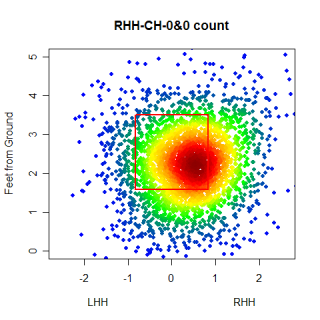
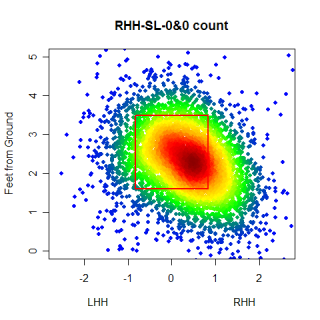
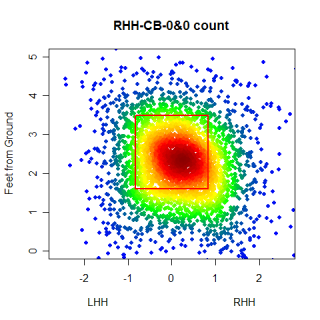
Again, you can't directly compare the scales from graph to graph, but you can get a good idea of where the different types of pitches are thrown. One thing that was somewhat interesting, especially after looking at these graphs, was the frequency that pitchers worked inside to RHH. 0&0 is a neutral count, so the pitcher has some choice with where he throws a pitch, but whats interesting is how the locations for different pitches in an 0&0 count compare to the locations for the same pitches in an 0&2 count.


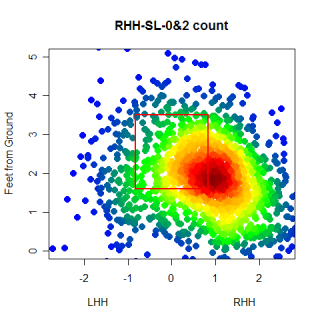
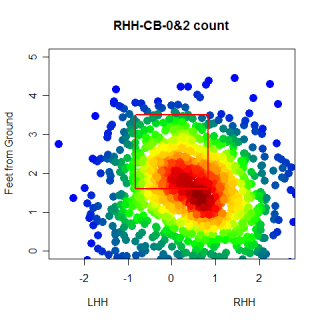
This is pretty neat. The locations are pretty much what we would expect, with more pitches being thrown out of the zone and at the corners than before. You can see that pitchers do go up in the zone with 0&2 fastballs and that 0&2 breaking balls are thrown down and out of the zone.
There is a ton more to learn from these graphs and similar pictures, however, I'm not going to be the person who does the majority of that discovering, at least not online. I've taken an internship with an MLB team and this is my last article for Baseball Analysts.
Sure the pay is low and the hours are long, but for a 23 year old baseball fiend, there's no cooler feeling than going to work at the ballpark everyday. Working in professional baseball is what I want to do. I'm deeply indebted to Rich for giving me the opportunity and space to write these articles on the pitch f/x system and I'm also in debt to the readers who forced me to be at (or near) the top of my game when I was writing articles. Writing for for Baseball Analysts has been a fantastic experience and I'm going to miss it, but I'm moving on and couldn't be happier with what the future holds. To quote The Boss, "good luck goodbye" (and thanks).
Comments
Great stuff, and good luck! You're leaving a void in the saber world.
Posted by: tangotiger at March 14, 2008 8:06 AM
Joe: You are going to be missed. You were one of the pioneers in gathering, analyzing, and writing about the Pitch f/x data. I had no doubt that a MLB team was going to snatch you up. I am thrilled for you. Congratulations.
Posted by: Rich Lederer at March 14, 2008 8:41 AM
Congratulations, Joe! And you will be missed, most definitely. You are one of the best, perhaps the best, of the PITCHf/x analysis crew. Your work last spring was very instrumental in getting me interested in this stuff and showing me what could be done.
Posted by: Mike Fast at March 14, 2008 9:14 AM
Joe, just out of curiousity, how much did your work here help you get that internship? I've been trying to convince my students about the benefits of blogging for their careers, and real life examples are always helpful.
Posted by: Charlie at March 14, 2008 10:17 AM
There's no question that blogging is incredibly useful. The three authors of The Book were all exposed to teams online, the Indians, DRays, Mets, Jays, Cards and many other teams all got some exposure be it online or via books of their saberguys.
You end up getting a "Wisdom of Crowd" process, whereby the rest of the community will eventually bump you up in terms of relevancy in a particular field by simply linking or talking about you.
Posted by: tangotiger at March 14, 2008 10:29 AM
Congrats Joe! Best of luck.
Posted by: Evan at March 14, 2008 12:14 PM
Good luck, Joe. We'll miss your contributions! But it sounds like a wonderful move for you. Best of luck, as long as you're not going to work for an NL Central team not named the Reds. :) -j
Posted by: jinaz at March 14, 2008 12:44 PM
Yes, Joe, best of luck with your new endeavor. Count me among those who benefited from your initial efforts with pitch f/x. Thanks for that!
Posted by: John Walsh at March 14, 2008 1:47 PM
Joe, best wishes for your future. You certainly have earned and deserved this chance, and thanks for all the superb work, which was very inspiring!
Posted by: Renè at March 14, 2008 2:18 PM
Yup, ditto all the above! Seriously, at some point demand (politely of course) that you get paid substantially. Someone eventually has to take a stand in terms of teams paying appropriately for sabermetric work that will net them literally millions of dollars per year.
Posted by: Mitchel Lichtman at March 16, 2008 5:33 AM
Congrats, Joe! This is fantastic news.
Charlie: Blogging has helped me launch two different careers over the past several years.
Posted by: Geoff Young at March 16, 2008 8:51 AM
Thanks for all the comments. It really means a lot to see that people enjoyed my work. The last year has been a tremendously educational and enlightening experience in terms of my baseball knowledge.
Thanks a bunch.
Posted by: joe p at March 17, 2008 1:03 PM
... your pitch f/x data couldn't help you in the NL-West-only league last year...
Posted by: Nasty Nate at March 18, 2008 9:53 AM
Joe, which team?
Posted by: jason at March 18, 2008 12:53 PM